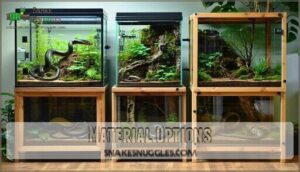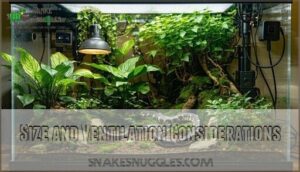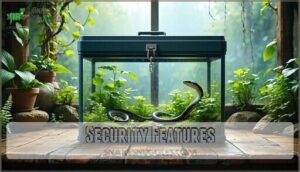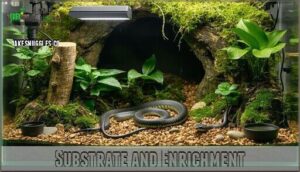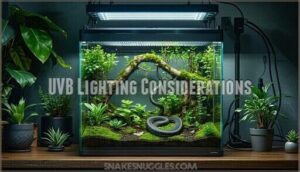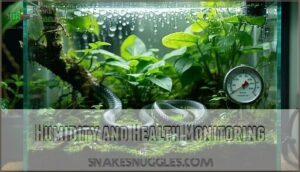This site is supported by our readers. We may earn a commission, at no cost to you, if you purchase through links.

You’ll need precise temperature gradients (typically 75-95°F), humidity levels between 40-70%, and proper ventilation to prevent respiratory issues.
Choose secure enclosures with appropriate substrates like cypress mulch or paper towels.
Install reliable heat sources, thermostats, and hygrometers for consistent monitoring.
Create hiding spots on both warm and cool sides, ensuring your snake feels secure.
Regular maintenance prevents bacterial growth and health problems.
Getting these fundamentals right transforms your terrarium from a simple box into a thriving ecosystem that keeps your serpentine friend healthy and stress-free—but the devil’s in the details.
Table Of Contents
- Key Takeaways
- Snake Environment Basics
- Enclosure Selection Guide
- Substrate and Enrichment
- Temperature and Lighting Management
- Humidity and Health Monitoring
- Frequently Asked Questions (FAQs)
- How can climate control help a pet snake?
- How do you keep a pet snake healthy?
- What is the best snake habitat climate control system?
- Do pet snakes need temperature and humidity control?
- Why should you care for your pet snake?
- Why is advanced snake habitat climate control important?
- Where to take unwanted pet snakes?
- What is the best pet for snake control?
- Will Petco take unwanted snakes?
- Do I need to wash my hands after touching my snake?
- Conclusion
Key Takeaways
- Create precise thermal gradients between 75-95°F using reliable heat sources like ceramic emitters or heat mats—your snake can’t regulate its body temperature internally and depends on you for proper thermoregulation
- Monitor humidity levels consistently between 40-70% using digital hygrometers and maintain them with water dishes, misting systems, or moisture-retentive substrates to prevent shedding problems and respiratory infections
- Install secure enclosures with tight-fitting lids and reliable locks, plus provide hiding spots on both warm and cool sides—snakes are escape artists and need multiple secure areas to reduce stress
- Maintain daily monitoring routines by checking temperature, humidity, and your snake’s behavior while keeping detailed records—consistent environmental control reduces stress markers by up to 60% in captive reptiles
Snake Environment Basics
Creating the right environment for your snake isn’t just about buying a tank and hoping for the best.
You’ll need to understand your specific species’ requirements for temperature, humidity, and lighting to keep your pet healthy and stress-free.
Researching Species Needs
Before diving into specific habitats, you’ll want to match your snake species research with your care capacity.
Different snake species have vastly different habitat needs—ball pythons thrive in grasslands while green tree pythons need rainforest-like conditions.
Understanding species-specific needs prevents costly mistakes.
Research snake behavior patterns, breeding methods, and adult sizes before committing.
Your lifestyle must align with requirements for humidity control, temperature control, and enclosure design to guarantee long-term success.
Creating a suitable environment also involves considering the snake’s natural wildlife habitat to replicate its native conditions accurately, ensuring a match with your lifestyle and research for the best outcome.
Temperature and Humidity Control
Temperature control acts as your snake’s lifeline, requiring precise thermal gradients from 75-95°F depending on species.
Your snake’s thermal gradient isn’t optional—it’s their survival system.
Create warm and cool zones using reliable heat sources like ceramic emitters or heat mats—never heat rocks.
Humidity levels between 40-70% prevent shedding problems and respiratory issues, and it’s crucial to monitor both constantly with digital thermometers and hygrometers for accurate moisture management and ideal snake health.
Lighting Requirements
Most snakes don’t require UVB lighting like their reptilian cousins, but they’ll benefit from consistent day night cycles.
You’ll want lighting timers to maintain 12-hour periods, mimicking natural rhythms. If you’re providing basking spots with heat lamps, make certain proper color temperature and heat lamp safety.
Quality lighting solutions support your snake’s circadian health without overdoing it. Understanding UVB lighting needs is vital for creating a healthy environment for your pet snake.
Enclosure Selection Guide
Selecting the right enclosure forms the foundation of your snake’s health and wellbeing throughout its lifetime.
You’ll need to balance material durability, proper sizing, and security features to create a habitat that keeps your snake safe while making maintenance manageable for you.
Material Options
Choosing the right enclosure materials sets the foundation for your snake’s long-term health.
Glass terrariums offer excellent visibility and ventilation control, making temperature monitoring straightforward.
Plastic enclosures provide superior humidity retention and lightweight portability.
Wooden vivariums deliver outstanding insulation properties but require proper waterproofing treatments.
- Glass terrariums feature crystal-clear viewing and easy cleaning but need careful temperature regulation
- Plastic enclosures resist moisture damage while remaining lightweight for easy repositioning
- Wooden vivariums provide natural insulation but require sealed surfaces to prevent water damage
- Secure lids with reliable locking mechanisms prevent escapes regardless of material choice
- Durable substrates work best with materials that resist warping and maintain structural integrity
When selecting enclosures, understanding glass terrarium benefits is vital for creating an ideal environment. Secure lids are essential with reliable locking mechanisms to prevent escapes. Using durable substrates is also crucial as they work best with materials that resist warping and maintain structural integrity.
Size and Ventilation Considerations
Once you’ve selected your enclosure material, proper enclosure size becomes your next priority.
Your snake needs breathing room – literally and figuratively. Ball pythons require minimum 40-gallon spaces, while corn snakes thrive in 40-75 gallon setups.
Ventilation systems with 3-4 air changes hourly prevent respiratory infections. Smart airflow management balances air circulation with humidity control, keeping your scaled friend healthy without compromising their comfort zone.
Effective ventilation systems are essential for maintaining ideal air quality and temperature gradients in the enclosure, ensuring a healthy environment for your snake through smart airflow management.
Security Features
Beyond proper sizing and airflow, you’ll need bulletproof security features to prevent escapes.
Secure enclosures require tight-fitting lids with reliable locking mechanisms—your pet snake’s Houdini skills are legendary.
Install secure locks on all access points and check for gaps larger than your snake’s smallest body dimension.
Snake proofing means addressing household dangers through proper enclosure safety measures and escape prevention protocols.
Effective snake enclosure design incorporates secure lock systems to guarantee the snake’s safety and prevent potential risks, ensuring a secure environment for your pet.
Substrate and Enrichment
Your snake’s substrate forms the foundation of its world, affecting everything from shedding success to stress levels.
The right combination of bedding, hiding spots, and enrichment items creates a habitat that supports natural behaviors while keeping maintenance simple for you, which includes providing the right combination of these elements.
Safe Substrate Options
Building the foundation right starts with substrate materials that won’t harm your snake.
Aspen shavings lead the pack—they’re dust-free, oil-free, and perfect for burrowing species.
Paper substrates like newspaper offer zero toxic substances and make cleaning a breeze.
Coconut fiber maintains humidity levels beautifully for tropical species.
Skip cedar, pine, sand, and corn cob bedding—they’re proven troublemakers for snake health.
Decor and Hiding Places
Once you’ve nailed your substrate options, it’s time to focus on decor and hiding places.
Snake hides and climbing structures aren’t just for show—they’re essential for snake hiding and stress reduction.
Visual barriers and hiding spots help your pet feel secure and encourage natural behaviors.
Consider these enclosure design upgrades:
- Multiple snake hides in warm and cool zones
- Branches for climbing structures
- Dense decor options for visual barriers
Water Features and Accessories
Your snake needs proper hydration beyond basic water bowls.
Install misting systems or foggers to maintain humidity levels between 40-70%.
Water features like shallow ponds or fountains provide enrichment for semi-aquatic species.
Change water weekly to prevent bacterial growth.
Monitor water quality with pH strips, ensuring temperatures match your snake’s thermal gradient for ideal drinking and soaking behavior.
Maintaining a healthy ecosystem requires understanding of bioactive systems to create a thriving environment for your pet snake, focusing on complete concepts and bioactive systems for a healthy pet.
Temperature and Lighting Management
Temperature management acts as your snake’s life support system, directly controlling its digestion, immune function, and overall health.
You’ll need to create a thermal gradient with precise heat sources and consider lighting requirements that match your species’ natural habitat patterns.
Thermal Gradient Creation
Creating effective thermal gradients requires strategic temperature control across your snake’s enclosure.
Establish a basking spot design on one end reaching species-specific temperatures, while maintaining cool zone options at the opposite end.
This temperature gradient allows snakes to thermoregulate naturally by moving between zones.
Use temperature monitoring tools like digital thermometers with probes to track both sides accurately.
Gradient maintenance involves consistent heat sources and regular monitoring to meet your species’ thermoregulation needs.
It is crucial to ensure that the temperature control is strategic to provide a healthy environment for your snake.
Heat Source Options
Four primary heat sources power your snake’s thermal needs.
Heat Mats provide gentle belly warmth for burrowing species, covering one-fourth of enclosure floor. Ceramic Heat Emitters deliver steady infrared heat without light, perfect for nocturnal snakes.
Heat Lamps create focused basking spots with directional warmth. Always pair these heating systems with reliable thermostats for temperature control and safety.
Proper heat source selection involves understanding infrared heat options to guarantee the well-being of your pet snake.
UVB Lighting Considerations
Beyond heat sources, UVB lighting offers significant reptile care basics benefits for many snake species.
While nocturnal snakes require minimal UVB light, diurnal species benefit from UVB benefits including vitamin D3 synthesis and improved calcium metabolism.
Install linear fluorescent tubes 12-18 inches above basking areas, maintaining natural day-night cycle photoperiod of 12 hours.
Choose 5.0 spectrum options for most species, avoiding overexposure, and replace bulbs every 6-12 months as intensity levels diminish, ensuring consistent lighting cycles for peak health.
Humidity and Health Monitoring
Maintaining proper humidity levels isn’t just about comfort—it’s essential for your snake’s health and successful shedding cycles.
You’ll need to monitor both humidity and your snake’s behavior regularly to catch potential health issues before they become serious problems.
Humidity Level Management
When managing humidity levels, you’ll need a hygrometer to track moisture accurately.
Most species thrive between 40-70% humidity, though tropical snakes require higher levels.
Control humidity through water misting, moisture-retentive substrates, and humid hides.
Place water dishes strategically to maintain healthy humidity levels.
Proper humidity management prevents shedding problems and respiratory issues, which is crucial for the healthy development of the species.
Health Issue Identification
Monitoring your snake’s health requires sharp observation skills to catch problems before they become serious.
A watchful eye catches health problems before they spiral out of control.
Watch for persistent food refusal lasting over two weeks, unusual discharge from the mouth or nose, and incomplete shedding cycles.
- Respiratory Issues: Look for wheezing, open-mouth breathing, or nasal bubbling
- Mouth Rot: Check for swelling, discoloration, or cottage cheese-like discharge around the mouth
- Shedding Problems: Monitor for retained eyecaps or patches of old skin that won’t come off
These signs of illness often point to environmental problems you can fix quickly with proper veterinary care.
Regular Maintenance and Care
Establishing cleaning schedules and record keeping systems transforms chaotic snake care into manageable routines.
Clean water bowls weekly, spot-clean waste immediately, and deep-clean enclosures monthly with reptile-safe disinfectants.
Document feeding tips, temperature control readings, and health observations to track patterns and catch issues early.
Maintaining essential humidity levels is vital for healthy shedding and overall snake well-being.
| Daily Tasks | Weekly/Monthly Tasks |
|---|---|
| Check temperature/humidity | Deep clean water bowls |
| Spot-clean waste | Replace substrate |
| Monitor snake behavior | Disinfect surfaces |
| Record observations | Review health logs |
Consistent enclosure maintenance and waste management prevent bacterial buildup that threatens your snake’s health.
Smart snake handling during cleaning reduces stress while maintaining proper snake environment control through systematic care routines.
Frequently Asked Questions (FAQs)
How can climate control help a pet snake?
Climate control creates the perfect thermal playground for your snake’s health.
You’ll maintain proper temperature gradients that support digestion, immune function, and natural behaviors.
Consistent humidity prevents shedding problems while regulated lighting cycles keep their biological clock ticking smoothly, ensuring proper temperature gradients are maintained for optimal health.
How do you keep a pet snake healthy?
Unlike wild snakes that face predators daily, you’ll monitor your pet’s temperature (75-95°F), humidity (40-70%), proper substrate, regular feeding schedule, clean water.
You’ll also watch for respiratory infections or shedding problems.
What is the best snake habitat climate control system?
You’ll want thermostat-controlled heating elements paired with digital temperature monitors for precise thermal gradients.
Combine ceramic heat emitters with under-tank heaters, plus hygrometers for humidity tracking—creating your snake’s perfect microclimate becomes manageable.
Do pet snakes need temperature and humidity control?
Yes, you’ll absolutely need temperature and humidity control for your pet snake.
Snakes can’t regulate their body temperature internally, so they depend on you to create proper thermal gradients and humidity levels for their health and survival.
Why should you care for your pet snake?
You’ll create a thriving partnership with your snake by providing proper care that prevents illness, reduces stress, and supports their natural behaviors. Well-maintained snakes live longer, healthier lives.
Why is advanced snake habitat climate control important?
Advanced climate control guarantees your snake’s thermoregulation, digestion, and immune function work properly.
Precise temperature gradients and humidity levels prevent respiratory infections, shedding problems, and metabolic disorders that can seriously compromise your pet’s health and lifespan.
Where to take unwanted pet snakes?
Like choosing between two doors—one marked "rescue" and another "dump"—your decision reveals everything.
Contact local reptile rescues, herpetological societies, or experienced keepers who’ll provide proper care rather than abandoning your snake.
What is the best pet for snake control?
You’ll find natural predators like owls, hawks, and foxes most effective for snake control.
However, encouraging these wildlife visitors through habitat creation works better than introducing specific "pest control pets" to your property, as it allows for a more natural and effective approach to managing the issue.
Will Petco take unwanted snakes?
Ironically, returning your slithery friend’s easier than getting rid of cable bills. Petco will gladly assist in finding homes or may take back healthy companion animals through their rehoming program.
Do I need to wash my hands after touching my snake?
Yes, you should always wash your hands after handling your snake.
Snakes carry Salmonella bacteria naturally, which can transfer to humans and cause serious illness.
Thorough handwashing with soap prevents infection.
Conclusion
Mastering pet snake environment control isn’t just theory—it’s proven science that directly impacts your snake’s lifespan and behavior.
Studies consistently show that properly controlled environments reduce stress markers by up to 60% in captive reptiles.
You’ve now got the framework to create an ideal habitat, but remember that consistent monitoring beats perfect initial setup.
Your snake’s health depends on maintaining these parameters daily, not just establishing them once, which requires patience and precision in adapting to your snake’s individual responses.
Success lies in these efforts, as they directly influence the well-being of your pet snake.
- https://www.jabberwockreptiles.com/news/temperature-ranges-for-pet-reptile/
- https://talis-us.com/blogs/news/optimal-temperature-ranges-for-corn-snakes
- https://reptifiles.com/corn-snake-care-guide/corn-snake-temperatures-humidity/
- https://www.evolutionreptiles.co.uk/blog/how-to-lower-humidity-in-vivarium/
- https://www.cambridge.org/core/journals/animal-welfare/article/survey-exploring-the-impact-of-housing-and-husbandry-on-pet-snake-welfare/7BED1DBAF7E7736788E3DEDAAC2A352D

